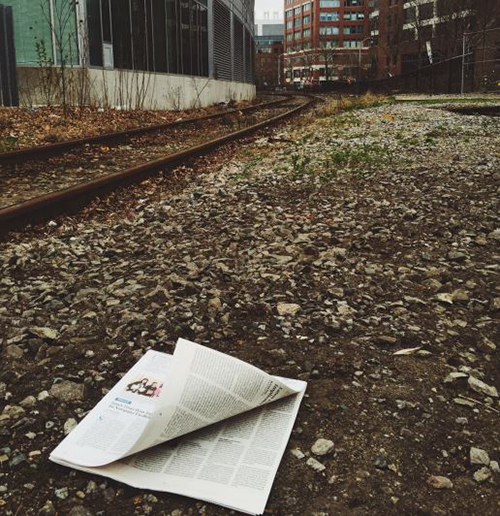Analyzing Online Media Reporting of Rail Suicide and Trespass Incidents
A report recently published by the U.S. Department of Transportation’s (U.S. DOT) Federal Railroad Administration (FRA) illuminates shortfalls in media reporting about rail suicide and trespass incidents.
Responsible media reporting on rail suicide and trespass incidents can inform the public and help those in need. However, media reporting of such events can also lead to copycat incidents.
Experts at U.S. DOT’s Volpe Center conducted the research, compiling 1,173 online media articles about FRA-reported suicide and trespass incidents—then, they compared those articles with professional recommendations about reporting on suicide to identify phrasing that does not follow best practices.
“We found several fairly common reporting practices that could increase suicide contagion on the rail system,” said Volpe psychologist Scott Gabree, one of the report’s co-authors.
Many media outlets in the study reported on suicide and trespass incidents in a manner consistent with recommendations. Still, many articles reported in ways that could lead to copycat incidents.
By looking at the patterns of incidents, the authors identify articles that had the potential to result in a copycat attempt.
For example, in New Jersey there were six rail suicide incidents during the study timeframe. Two of those six incidents occurred within one week of the previous incident. In both cases, at least one of the reports about the first incident highlighted the act of suicide by using “suicide” in the headline, and in several cases described the actions of the individual involved.
Reporting recommendations nearly always discourage including “suicide” in a headline about a specific incident, and discourage providing specific details of an incident.

“What we hope to convey is that if a media outlet does identify an incident as a rail suicide, they also include help information,” said Volpe psychologist Scott Gabree. "Responsible reporting can save lives on our nation’s rail system.” (Volpe photo)
Recommendations for Responsible Media Reporting
The International Association for Suicide Prevention provides recommendations for media reporting on suicide from 16 different countries. Here are a few key recommendations that Volpe experts analyzed, and their related findings:
- Do not include the term “suicide” in the headline of an article—this can sensationalize a particular incident and highlight the potential notoriety of such an act.
- Nearly 25 percent of analyzed articles about FRA-reported suicide incidents included the term “suicide” in their headlines.
- Nearly 25 percent of analyzed articles about FRA-reported suicide incidents included the term “suicide” in their headlines.
- Do not provide detailed information on where a suicide occurred.
- The name of a specific crossing, street, or station was provided in 26 percent of analyzed articles about FRA-reported suicide incidents.
- The name of a specific crossing, street, or station was provided in 26 percent of analyzed articles about FRA-reported suicide incidents.
- Do not provide vivid depictions and details of the event. This can create imagery that a vulnerable individual may relate to and consider acting upon.
- 45 percent of analyzed articles about FRA-reported suicide incidents included details about behaviors immediately before train-person collisions.
- 45 percent of analyzed articles about FRA-reported suicide incidents included details about behaviors immediately before train-person collisions.
- Do not include an image of a train. Although including an image of a train may seem reasonable, doing so depicts the manner of suicide, which is strongly discouraged.
- 16 percent of analyzed articles about FRA-reported suicide included an image of a train, and the majority of those articles included “suicide” in their headlines.
- 16 percent of analyzed articles about FRA-reported suicide included an image of a train, and the majority of those articles included “suicide” in their headlines.
- Include information for those seeking help.
- Among articles where the reporter identified an incident as a rail suicide, only 5 percent included such information.
Not every article includes a cause of death, and in some cases an official determination may take weeks or months.
“What we hope to convey is that if a media outlet does identify an incident as a rail suicide, they also include help information,” Gabree said.

Next Steps for Encouraging Responsible Reporting
FRA and Volpe will work with rail carriers to pilot and evaluate a strategy to improve media reporting. This initial pilot will focus on the Northeast Rail Corridor to test and evaluate an initial strategy within a relatively small geographic region.
FRA and Volpe will:
- Identify Northeast Rail Corridor stakeholders who may have a role in promoting responsible reporting. These may include journalists, editors, rail officials, police officials, train crews, first responders, and community members interviewed about an incident.
- Develop specific recommendations for each stakeholder that detail how they may improve their communications about a rail incident.
- Define a strategy to engage with stakeholders and disseminate recommendations so they may be used by all involved with the media.
- Work with stakeholders to assess the impact of these recommendations and modify as needed.
“I hope that what reporters take away from this investigation is that the pen truly is mighty—what they write and what they say matters,” Gabree said. “Our goal is not to be prescriptive. Rather, we’re trying to bring into stark relief that responsible reporting can save lives on our nation’s rail system.”
Read the report: Reporting of Suicide and Trespass Incidents by Online Media in the United States.
National Suicide Prevention Lifeline
If you or someone you know are in crisis or need to talk, please call the National Suicide Prevention Lifeline anytime, 24 hours a day, 7 days a week, at 1-800-273-TALK (8255) or visit http://www.suicidepreventionlifeline.org.

